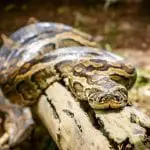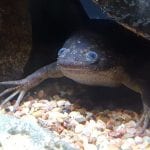Scientific Facts
| Common Name | Bearded Dragon |
| Scientific Name | Pogona Vitticeps |
| Life Span | 8 to 10 years (in captivity) |
| Size | From 4 inches (hatchlings) to 2 feet (adults) |
| Habitat | Woodlands, deserts |
| Country of Origin | Central Australia |
Physical Description
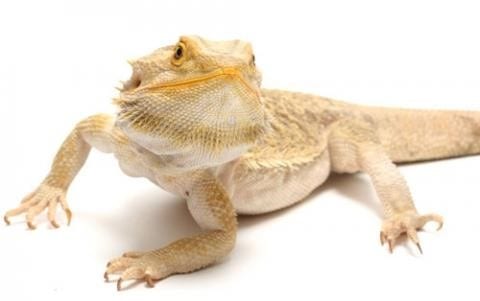
Bearded dragons are usually tan to yellow in color. As suggested by its name, it is called “bearded” due to its natural ability to flare out the skin in their throat area when it feels territorial or threatened. The body of bearded dragons features a flattened appearance, becoming even more noticeable when the dragon feels alert and alarmed.
There are usually spines on its throat, the sides of the body and the sides of the head. The head of these bearded dragons is usually wedge-shaped, with a tail that is as long as its actual body. Distinguishing the gender of bearded dragons is quite difficult, especially among hatchlings and young ones. Gender becomes more apparent when they become adults. The males usually have bigger heads and darker beads. On the other hand, the femoral pores of male bearded dragons also help in distinguishing them from the female group.
Types
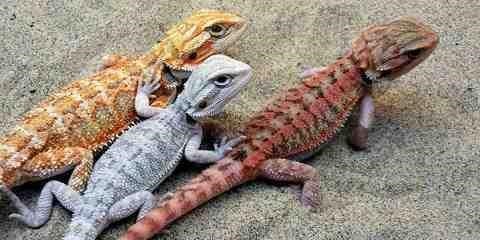
Bearded dragons come in different types, species, and colors. This is usually done by breeding two or more types of bearded dragons together, especially those with attractive traits in order to produce an offspring that features desirable characteristics.
Leatherback Bearded Dragons
These leatherback bearded dragons come with mutated genes that prevent their scales from developing to full size. This provides them with more number of smaller scales that make them feel and appear smoother. The smaller scales also improves the color of the dragon.
German Giant Bearded Dragons
These bearded dragons are bred by combining parent dragons that are larger than the average-sized bearded dragon. The repetition of this breeding has resulted in the creation of a breed of bearded dragons which are about 50% larger in size than the regular ones.
Silkback Bearded Dragons
Silkback bearded dragons are a result of breeding together two leatherback dragons. The resulting breed features a smoother appearance. The scales are usually so small that they look as smooth as their skin. These bearded dragons also come in a wide range of colors.
Life Span
The most common bearded dragon variety currently available in the central bearded dragon. In captivity, their average lifespan is 8 to 10 years.
The three stages of growth of bearded dragons are as follows:
Hatchling
A bearded dragon is considered a hatchling at 0 to 6 months. This part of the growing process is when rapid growth usually happens. It is very important that you feed your dragon the right diet at this stage.
Juvenile
Bearded dragons are considered juvenile at 6 to 12 months. More growth is expected when dragons reach this stage. In fact, it will begin to slow down from this point on.
Adult
Adulthood among bearded dragons is when they reach 12 months onward. 99% of their growing and development has already been completed at this point. This means that the diet should now shift from proteins to all-round conditioning and healthy food.
Eating Habits
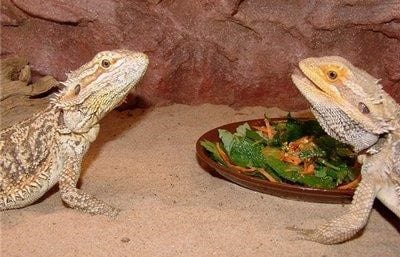
The diet of bearded dragons is important in making sure that they stay active and healthy. Feeding these pets may seem complicated, but by following simple instructions, you can ensure that your bearded dragons stay happy and healthy.
The diet depends on their age. Baby bearded dragons need to eat more insects instead of vegetables since they are still growing. While it is still recommended to leave some fresh vegetables inside the cage, it is important to feed your pets with insects three times a day. After mealtime is finished, the remaining insects should be removed from the tank.
Adult bearded dragons no longer need to eat as many insects as required when they were younger. Too much feeding of your dragon may only result in becoming overweight. Adult dragons need to consume insects once every day. Feed your adult bearded dragons as many insects that they can eat in a period of 10 to 15 minutes, and then remove the remaining insects out of the tank.
Sleeping Habits
Bearded dragons are considered as diurnal. This means that they are typically active at daytime, and are asleep at night. They also go through a period of brumation, which is a form of reptile hibernation.
Water
Since by nature, bearded dragons come from the desert areas, they are well-adapted to dry conditions. In the wild, they primarily get their water from plant materials and insects they eat. However, when kept in captivity, they need a fresh, clean water source every day so that they stay hydrated.
Certain leafy green vegetables, including collards and kale, can provide moisture. It is also recommended to lightly mist fruit and vegetable items with a little water before feeding your snake in order to increase water intake.
They should also be given a bowl of fresh water every day. A shallow water bowl is recommended in order to prevent your dragon from falling and potentially drowning. The water should be washed thoroughly with the water replaced. Doing this in the morning is the best time to replace the water from the previous day.
If you are using tap water, it is recommended to use a water conditioner. This will remove the presence of chlorine as well as other unwanted minerals out of the water.
Development and Reproduction
Bearded dragons reach their sexual maturity at 8 months old. However, this can still be too early for them to start reproducing. It is best to wait for about a year and a half to start breeding.
Around mid-to-late February, conditions of the environment will be back to normal. After a few days of longer days and higher temperatures, bearded dragons will start getting their appetite back. At this point, they need to be heavily fed, especially the female dragons who need to support egg development aside from their metabolic requirements.
Supplementation of calcium is also important at this time. Increased dietary calcium among pre-breeding females is essential in order to prevent calcium deficiency after laying eggs. After a month, you can start seeing courtship in the lizards. The throats of the male dragons will start to darken. They will also show head bobbing, which is a sign of being interested in their female counterparts.
The females, on the other hand, show their response through head bobbing, along with an arm-waving behavior, which is shown to be a sign of acceptance. Copulation will usually occur a number of times throughout a period of few months.
How to Breed
Egg-laying usually happens 4 to 6 weeks after a successful mating. Females will become very plump. In fact, at times, the outlines of the eggs may be seen through the abdominal wall of the females. As the eggs start to grow inside, she will start eating less and less, even fasting for a few days before laying.
When the female is now ready to lay eggs, she will start searching for a good spot to deposit her eggs. She may start digging the corners of her enclosure. When you notice this, you may want to place a suitable spot for her to deposit her eggs. This may come in the form of a box or a deep pan of sandy, moist soil.
Common Health Problems
Even though bearded dragons are robust reptiles, they can still end up developing some health issues while in captivity. These problems often come as a result of the improper growing environment. At times, it is caused by poor genetics. The following are some of the most common health problems among bearded dragons:
Impaction
Impaction is often regarded as among the most common causes of death among bearded dragons in captivity. This starts from the blockage inside the digestive tract when they swallow objects that do not get digested. Usually, this condition is caused by smaller particle substrates which the animal accidentally ingest when looking for insects.
Once they start showing signs of impaction, it is often too late. When detected early, the dragon can go through surgery in order to remove the impaction, though it can be a costly endeavor, and not to mention, painful. Unfortunately enough, most cases of impaction result in death.
Mouth Rot
This is a bacterial infection usually caused by unclean living conditions and low terrarium temperatures. The symptoms include dark coloration of the gums, lips or tongue. It can get worse as time passes by, causing the gums to bleed, and the teeth eventually falling out.
To prevent mouth rot, make sure to keep the terrarium sanitized and clean. Remove leftover food items or feces as soon as possible. Maintain the right temperatures of the area depending on the age of the bearded dragon.
Metabolic Bone Disease
This is a debilitating skeletal disease which is common among bearded dragons in captivity. This is characterized as a breakdown of the skeletal system because of the lack of calcium absorption in the bones. The usual cause is inadequate UVB exposure or a lack of calcium intake.
UVB rays coming from the sun usually helps in the production of Vitamin D3, thus promoting calcium absorption. Without the right levels of Vitamin D3 within the digestive system, calcium is not synthesized, which in turn, results with the bones becoming brittle, weak and deformed.
Preventing Illness
Just like humans, bearded dragons are also exposed to different kinds of health issues, not just the ones mentioned above. To prevent illness, it is recommended to observe the best husbandry practices that can be done in order to help in preventing possible undesirable conditions.
It is also advisable to provide your bearded dragon with nutritious food items and make sure to add calcium, as well as multivitamin supplements at every feeding. Also, it is best to use high-quality, full-spectrum lighting and other heating elements while monitoring temperatures.
Behavior
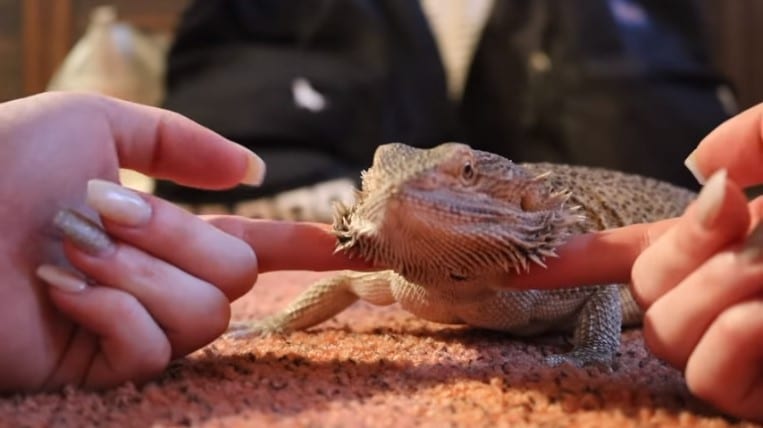
Just like humans, bearded dragons show specific body language which indicates their feeling, health, and mood. One thing to note, however, is that bearded dragons do not naturally mimic other bearded dragons, which means that their behaviors are genuine always.
Most dragons show a certain behavior when a female is around, when another dragon approaches them, or when a bigger animal comes close to them.
Head bobbing
This action is more commonly observed among males. Bearded dragons raise and lower their head repeatedly. This action is usually a sign of dominance when two dragons are together. Male bearded dragon also does the head bob at females, showing their dominance while mating. The faster the head bobbing is, the more threatening it is. Usually it has something to do with territorial reasons. A slower head bobbing, on the other hand, maybe a sign of submission and yielding.
Arm Waving
Arm waving happens when a bearded dragon stands high on three legs while raising the other leg in the air, waving it in a circular motion. There are other possible meanings of this move. One is recognition. If a bearded dragon waves at another of its kind, it means that he or she is well aware of the other’s presence.
Another possible meaning is submission. Arm waving may be done whenever a larger bearded dragon approaches them, or whenever any larger animal approaches the bearded dragon.
Tail Twitching
This happens when the tail of a bearded dragon twitches, similar to that of a cat’s tail. Not all dragons do this, but if your pet does so, it could be an indicator of your pet’s mood. Owners observe that their pet’s tail twitches when they are hunting for prey, or when they are stressed. At times, during the breeding period, two bearded dragons twitch their tails.
Brumation Cycle
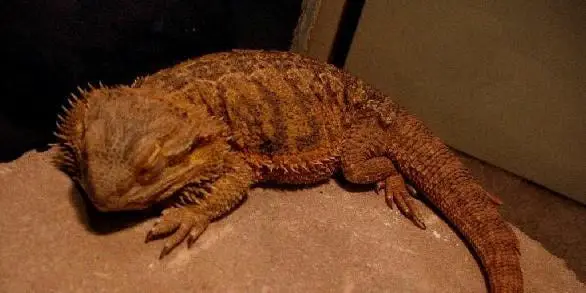
Brumation refers to the hibernation cycle that bearded dragons usually go through. They usually go through a brumation stage in the fall, or winter as a response to the changes in temperatures or lighting. Other owners try to prevent this by adjusting the lighting and temperatures of the cage manually. It is still recommended, however, to allow your bearded dragon to do what naturally happens. Otherwise, it may have an impact on their health.
During this cycle, your bearded dragon will be less active, and will just sleep for a longer period of time. Their appetite may also decrease, or even stop eating altogether. This is just natural. If your bearded dragon is healthy, then they will not lose any weight even without eating anything.
Shedding
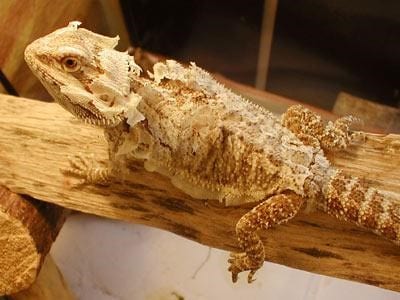
Since bearded dragons are reptiles, it is expected that they will go through shedding. Younger bearded dragons frequently shed as a response to their bodies growing. Adult bearded dragons, however, may only shed once or twice every year.
Before they shed, you will observe their color becoming duller, with their eyes being puffed out more than normal. These are signs of an expected healthy shedding. During the period of time that they will shed, it is important to make sure that your dragon stays hydrated and clean. This can be done by bathing them with warm water. Use a spray bottle to mist the skin of your dragon occasionally to keep it hydrated throughout the shedding process.
Habitat
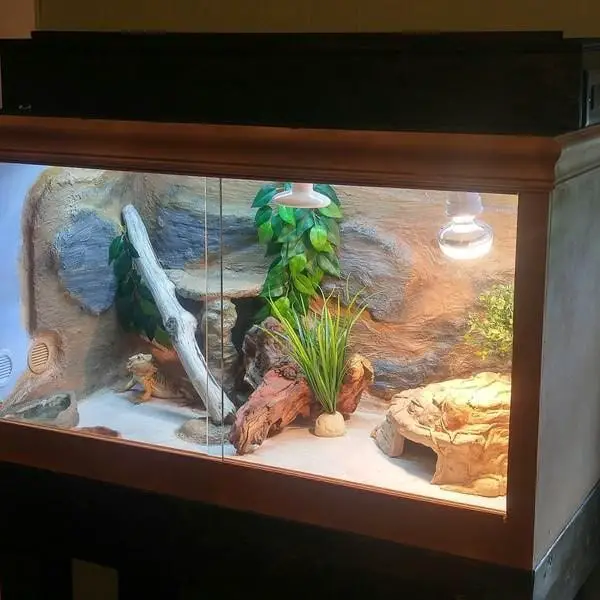
Whether you prepare a cage, tank or terrarium, the habitat of your bearded dragon will serve as his or her home for the next few years. So as to expect a happy and healthy bearded dragon, it is vital to ensure that their habitat meets their specific needs.
Once you have carefully selected a cage or tank for your bearded dragon, the next thing that you will need to secure is a cover or lid. This is important to prevent your pet from possibly escaping. Note that these reptiles are escape artists. Avoid using plastic, glass or other types of solid tank-lids which may restrict the flow of air.
To keep the humidity low and healthy, and to prevent your pet from escaping, you may want to use a screen lid cover for your tank. Reliable screen covers are durable enough to support the weight of the lights, and can also withstand any heat produced by the heat lamps.
Lighting and Humidity
One thing is for sure when it comes to considering the lighting for your bearded dragon. The brighter your cage or tank is, the happier your pet will be. Bearded dragons originated from the deserts of Australia, which means that they need full-spectrum lighting for 12 to 14 hours every day.
These full-spectrum lights are not the same as the ones that we use in our homes. This light has to be spread evenly throughout the cage. There should also be a way for your dragon to come near the light source within 6 to 8 inches. This means that you can place either a rock, branch, or platform in which your bearded dragon can lie on close to the light.
Temperature
Bearded dragons came from a desert-like environment. To mimic such kind of living conditions, the tanks and cages have to be heated. In general, a cage should have a hot side, with a temperature between 95 degrees Fahrenheit and 100 degrees Fahrenheit. A cool side should also be prepared, where the temperature is at about 85 degrees Fahrenheit. For this, it is recommended to have two thermometers ready.
Your pet will appreciate it if you prepare a basking spot where he or she can bask under the heat. This spot should be about 95 degrees Fahrenheit in temperature for adults, and 110 degrees Fahrenheit for juveniles. Avoid using a heated rock for your pet because they can burn their underside. Rather, use either a ceramic heater, a reptile basking heat, or a household light bulb which emits heat.
Tank Bedding and Accessories
Aside from taking care of the lighting and temperature inside the cage or tank, it is also important to pay attention to the flooring of the tank. The kind of flooring that is recommended depends on the actual age of your pet. Since younger ones need to feed on more insects compared to older dragons, it is important to be more careful regarding the flooring since it could be possible that a younger bearded dragon will also eat a bit of it while trying to catch their prey.
Sanitation
For hygiene and sanitation, make sure that you regularly clean the cage, water bowl, and food bowl using a sanitation product specially formulated for this reason. Make sure to clean all items after cleaning, allowing them to dry before setting up the cage again. Also, since bearded dragons can carry salmonella bacteria, it is recommended to wash your hands after handling it or carrying its cage.
Natural Environment – Substrate
There are a variety of substrates that you can use. Shrubs, tree growth and bush can be added inside the living environment of your bearded dragon. These substrates may range from hard compact soil, clay, and leaf-litter, to a more familiar red sand that is typically featured in wildlife shows in Australia. Your pet will love it when their set up and vivarium will reflect their natural habitat.
Hydration
It is best to use a water bowl in your set up. It is recommended to have a small bowl or one that they could not possibly lay in, as this may result in concerns such as a scale rot. If you do not use a water bowl, it is recommended to provide a different source for hydration. It should also be noted that bearded dragons get 99% of their needs in hydration from the greens that they consume, aside from fully-hydrated food.
Availability – Where to Get One?
Bearded dragons can be purchased from pet stores, especially those that sell reptiles. While you can visit local stores, there are also options to purchase bearded dragons from online sources.
How to Care for a Bearded Dragon?
Here are some tips on how to care for a bearded dragon:
- Bearded dragons are generally easy to handle if you hold their flat, wide bodies from underneath. They also love walking from hand to hand as they move around. They can also be handled by children, provided that the children are also supervised by adults.
- Bearded dragons need three things in their cage – a good UV light, heat, and moisture. The light should be given during the day as it will help in making sure that your pets can still make Vitamin D in their skin, which is essential to their health.
- Adequate humidity is also needed in order to stay hydrated and to properly shed skin. Soaking them, or misting them, or giving them a shallow water bowl where they can climb into, is recommended.
FAQs
How much does a bearded dragon usually cost?
Most pet stores sell young bearded dragons with prices ranging from $30 to $60. The adult ones are generally more expensive, costing up to $100. In general, you can get a bearded dragon at a cheaper price when purchasing from a local store.
Can bearded dragons recognize their owners?
Beard dragons respond and recognize their owners’ voices and touch. As such, they are good pets for owners who want to have a reptile who wants to be held. When handling a bearded dragon, it is recommended to wash after, since all reptiles are known to carry salmonella bacteria.
How often should bearded dragons be fed?
For young bearded dragons, 30 to 80 crickets of appropriate sizes may be given in a day. Before reaching 2 to 3 months, these younger bearded dragons should also be fed 3 to 5 times every day. When they reach 3 to 8 months, they need to be fed twice a day.
Can bearded dragons hear their owner?
Yes, they have a sense of hearing. In fact, they can hear really well. Bearded dragons are also extremely sensitive to any vibration, and can even detect movements.
How often do bearded dragons defecate?
The answer usually depends on the actual age and diet of the pet. If it is still a hatchling, they defecate at least once a day. Adult bearded dragons, on the other hand, especially when fed with silkworms, also defecate once a day.
What happens when a baby bearded dragon is overfed?
It is very important to avoid overfeeding a baby bearded dragon. This may put pressure on their nerves, thus causing paralysis in the rear legs. In extreme cases, this may even result in death. Baby dragons need a lot of food but in smaller, and frequent servings. The recommended food for these young bearded dragons is small crickets, wax worms, and molted mealworms.
Do bearded dragons love to be petted?
Yes they do. However, it is best to start slowly by stroking its head and sides of the face. A bearded dragon can also be petted from head to tail, doing so slowly and gently. Avoid standing right over the head as you pet the dragon, as they usually feel threatened by any movement right above them.
I can see something white in the poop of my dragon. What is that?
A healthy poop should have that white part, called urates. This refers to the waste products coming from the kidneys. Since bearded dragons do not pee, urates gather in their guts and come out together with their poop. This is similar to that of other reptiles.
How often should bearded dragons be given a bath?
It is recommended to allow your pet to splash around warm water once a week. During the summer months, doing so twice a week is also recommended. Bathing helps in the overall hygiene of your pet as it removes old scales and skin.
How can you determine the age of a bearded dragon?
One way to determine the age of a young dragon is by actually measuring it from head to tail. In general, the length of a dragon represents its age up to a specific point.
Is it normal for a bearded dragon to close its eyes when petted?
When bearded dragons close their eyes when being petted, it shows that they do not like being held. If you can hold your pet and it does not close its eyes, it means that it’s fine. If you notice your pet closing its eyes as soon as you pet it, holding it is enough.
How can I tell if my bearded dragon has parasites?
Parasites are quite common in the intestinal tract of bearded dragons. Pinworms, especially. No clinical signs may be seen, but these parasites can be detected by doing an annual fecal examination. In certain cases, parasites may result in weight loss or diarrhea. Ticks and mites may also be found on their skin.
Are bearded dragons smelly?
Yes, especially if you do not take care of them properly. As such, make sure to give focus on its hygiene, using sanitary practices when handling it. Neglecting to clean the habitat of your pet will also make your bearded dragon smell.
Is it fine for my bearded dragon to drink tap water?
A shallow water bowl is recommended to prevent your pet from falling and drowning. When using tap water, it is also ideal to use a water conditioning product such as ReptiSafe. These types of products remove unwanted minerals and chlorine from the water.
Is it possible to potty train a bearded dragon?
Yes it is possible. They can be trained to defecate consistently in a certain area of the average-sized cage.

